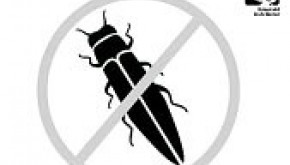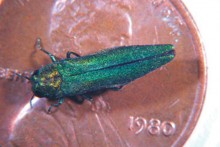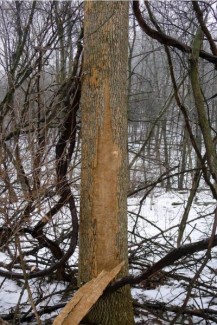
This month Women Owning Woodlands is focusing on invasive species - a subject I spend a great deal of time thinking about. As I was writing the post about the recent discovery of emerald ash borer (EAB) in Minnesota's woods I realized the Women Owning Woodlands website doesn't have an article about EAB. Something I will now correct.
Emerald ash borer, or EAB, is an invasive beetle first discovered in Detroit, MI in 2002. We now know it is originally from China and was likely imported in packing materials, like pallets, that arrived into the Detroit port. We've learned it is extremely deadly to the ash (Fraxinus spp.) trees in North America. Left untreated it kills 99% of those trees it infests. This is a bad deal for us, the environment and, of course, ash trees!
Ash is a large and important component of some the forests in the Lake States and elsewhere. In Minnesota's north woods some the wet forest stands are over 50% ash trees. Many of the hardwood forests in the upper Midwest have some ash in them, particularly in wet areas.
EAB has also proved very troublesome and expensive for cities. Ash is a common urban tree. It has nice form, grows well in many urban locations and is easy to grow. As a result it was commonly planted after Dutch elm disease killed many of the urban elms. In many of Minnesota's cities ash is now between 20-30% of the urban tree canopy. EAB will be a challenge for cities to manage; mass ash removal can be a real budget buster!
While the prospects are glum you can make a difference! Our forests need all eyes on the look-out for EAB. If you're unfamiliar with the D-shaped exit holes and S-shaped galleries that can be clear evidences of its presence be sure to check them out at the University of Minnesota Extension's EAB webpage. This website also has materials that show similar insects and offers helpful tips on identifying ash trees.
If you are an Master Volunteer, like a Woodland Advisor, Master Gardner, Master Naturalist or Tree Care Advisor, or are an engaged landowner or forestry or tree care professional consider becoming a Forest Pest First Detector. This network of dedicated volunteers is responsible for the initial EAB find in Minnesota back in 2009 and has helped detect several other incidents of EAB and gypsy moth throughout the state.
If you're a landowner with ash on your woodlands be sure to start your management plan now! It's likely not too late to start preparing your forest for a healthy future. A good resource to help you understand the issue and start thinking about specific management goels is the Ash Management Guide.
EAB is one of many serious forest health issues facing our forests. EAB, along with a lengthy list of other invasive plants, insects and diseases, is posed to change the way our forests, look, feel and function. Add to this the uncertainty of our future climate and we need everyone who loves the woods to step up and start making a difference! Being an engaged woodland owner - and talking with your family about your management goals - is the first step!



